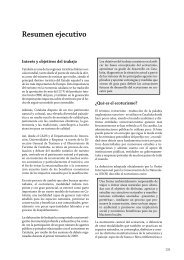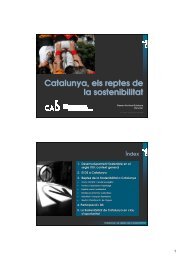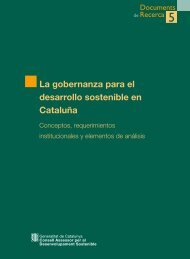Estratègies per al desenvolupament sostenible - Generalitat de ...
Estratègies per al desenvolupament sostenible - Generalitat de ...
Estratègies per al desenvolupament sostenible - Generalitat de ...
You also want an ePaper? Increase the reach of your titles
YUMPU automatically turns print PDFs into web optimized ePapers that Google loves.
new policies, policy changes and links for improved coherence;new and changed legislative, economic or other instruments which assistimplementation of policies or build capacities;major programmes and pilot projects for sustainable <strong>de</strong>velopment and changemanagement;sustainability gui<strong>de</strong>lines and standards for sector activities and institution<strong>al</strong> roles.The strategy action plan/framework would, therefore, comprise existing activities aswell as specifying new ones. It would note where existing resources are a<strong>de</strong>quatefor implementation, and where extra (outsi<strong>de</strong>) investment is nee<strong>de</strong>d. However, itwould not offer a step-by-step blueprint for each action.Institution<strong>al</strong> planAn institution<strong>al</strong> plan covers the roles, partnerships and systems required to implementthe strategy. This may inclu<strong>de</strong> linkage between the NSSD and other strategic plansand between plans at different spati<strong>al</strong> levels: nation<strong>al</strong>, sub-nation<strong>al</strong>, loc<strong>al</strong>, or fordifferent sectors or geographic<strong>al</strong> regions. It would i<strong>de</strong>ntify which institutions areresponsible for which parts of the strategy action plan, their <strong>de</strong>grees of freedom andwhere they have an obligation to <strong>de</strong>fer to other stakehol<strong>de</strong>rs or strategy coordinators.It might <strong>al</strong>so sign<strong>al</strong> a ration<strong>al</strong>e for streamlining institutions (especi<strong>al</strong>ly where responsibilitiesoverlap or conflict) or even propose the establishment of new institutions as necessary.NSSD processes have ten<strong>de</strong>d to use <strong>de</strong>cision-making processes that are tootechnocratic, and often politic<strong>al</strong>ly naive. In most, if not <strong>al</strong>l, countries, many of the‘re<strong>al</strong>’ <strong>de</strong>cisions that profoundly affect society and steer the direction of <strong>de</strong>velopmentare essenti<strong>al</strong>ly and fundament<strong>al</strong>ly politic<strong>al</strong>, not technic<strong>al</strong>, <strong>de</strong>cisions. They reflect overtlyor implicitly some v<strong>al</strong>ue sets over others, and they involve many obvious or subtlemechanisms to make the voices of some stakehol<strong>de</strong>rs count for much more thanothers. They may involve “behind the scenes” negotiations, and may use consensusbuildingprocesses to particular ends (eg. tra<strong>de</strong>s union negotiations and making<strong>de</strong><strong>al</strong>s with business in privatizing public functions).This implies the need for changes in patterns of governance through the continue<strong>de</strong>xercise of strategy <strong>de</strong>cision-making, rather than <strong>de</strong>cision-making <strong>per</strong>ceived simply165
















